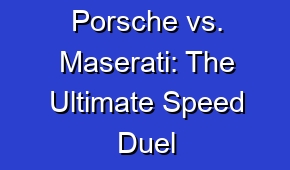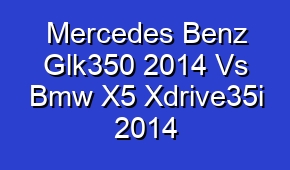Bmw i3 2014 Vs Bmw i8 2014

Compare the 2014 BMW i3 and the 2014 BMW i8 to discover the key differences between these two electric vehicles. Find out which model offers better performance, range, and design features. Choose the perfect BMW electric car for your needs and preferences.
| Feature | BMW i3 2014 | BMW i8 2014 |
|---|---|---|
| Engine Type | Electric | Hybrid |
| Powertrain | Rear-Wheel Drive | All-Wheel Drive |
| Motor Power | 170 hp | 357 hp |
| 0-60 mph Acceleration | 7.2 seconds | 4.2 seconds |
| Top Speed | 93 mph | 155 mph |
| Battery Range | 81 miles | N/A (Petrol engine provides additional range) |
| Fuel Efficiency | N/A (Electric vehicle) | 76 MPG (combined) |
| Transmission | Single-Speed Automatic | 6-Speed Automatic |
| Seating Capacity | 4 | 2 |
| Body Type | Hatchback | Coupe |
| Weight | 2,634 lbs | 3,285 lbs |
| Dimensions (L x W x H) | 157.4″ x 69.9″ x 62.1″ | 184.6″ x 76.5″ x 50.7″ |
| Charging Time | ~3.5 hours (Level 2 charger) | N/A (Plug-in hybrid charges while driving) |
| Regenerative Braking | Yes | Yes |
| Carbon Emissions | Zero | 49 g/km (combined) |
Engine Type
The BMW i3 2014 is an electric vehicle, while the BMW i8 2014 is a hybrid. The i3 solely relies on electric power, while the i8 combines a petrol engine with an electric motor.
Powertrain
The BMW i3 2014 has a rear-wheel drive system, while the i8 2014 features an all-wheel drive system. This means that the i3’s power is delivered to the rear wheels, while the i8 distributes power to all four wheels.
Motor Power
The BMW i3 2014 has a motor power of 170 horsepower, whereas the i8 2014 boasts a more powerful 357 horsepower. The i8’s hybrid system provides it with significantly higher power output compared to the i3.
0-60 mph Acceleration
The BMW i3 2014 takes around 7.2 seconds to accelerate from 0 to 60 mph, while the i8 2014 achieves this feat in just 4.2 seconds. The i8’s superior power and performance capabilities allow it to accelerate much faster.
Top Speed
The BMW i3 2014 has a top speed of 93 mph, whereas the i8 2014 can reach a maximum speed of 155 mph. The i8’s sporty design and more powerful engine enable it to achieve a higher top speed compared to the i3.
Battery Range
The BMW i3 2014 has a battery range of 81 miles on electric power alone. On the other hand, the i8 2014 does not have a specific battery range as it is a plug-in hybrid that utilizes a petrol engine to provide additional range when needed.
Fuel Efficiency
The BMW i3 2014 does not consume any fuel as it is an electric vehicle. In contrast, the i8 2014 achieves an impressive fuel efficiency of 76 MPG (combined) due to its hybrid powertrain.
Transmission
The BMW i3 2014 is equipped with a single-speed automatic transmission, while the i8 2014 features a 6-speed automatic transmission. The i8’s transmission allows for more control and flexibility in different driving situations.
Seating Capacity
The BMW i3 2014 can accommodate four passengers, whereas the i8 2014 has a seating capacity of two. The i3 offers more space for additional passengers, making it a more practical choice for small groups or families.
Body Type
The BMW i3 2014 is designed as a hatchback, providing versatility and ample cargo space. On the other hand, the i8 2014 is a sleek coupe, emphasizing its sporty and aerodynamic characteristics.
Weight
The BMW i3 2014 weighs approximately 2,634 lbs, while the i8 2014 is heavier at around 3,285 lbs. The i3’s lighter weight contributes to its efficiency and nimble handling, while the i8’s additional weight is due to its hybrid components.
Dimensions
The BMW i3 2014 measures 157.4″ in length, 69.9″ in width, and 62.1″ in height. In comparison, the i8 2014 is larger, with dimensions of 184.6″ in length, 76.5″ in width, and 50.7″ in height. The i8’s bigger size provides a more commanding presence on the road.
Charging Time
The BMW i3 2014 requires approximately 3.5 hours to fully charge using a Level 2 charger. In contrast, the i8 2014 does not have a specific charging time as it charges its battery while driving through its hybrid system.
Regenerative Braking
Both the BMW i3 2014 and the i8 2014 feature regenerative braking systems. This technology allows the vehicles to recover and store energy generated during braking, thereby increasing efficiency and extending battery life.
Carbon Emissions
The BMW i3 2014 produces zero carbon emissions as it operates solely on electric power. However, the i8 2014 emits 49 g/km of carbon dioxide (combined) due to its hybrid nature and the use of a petrol engine.




















